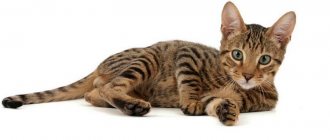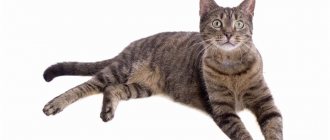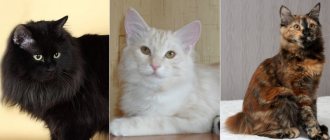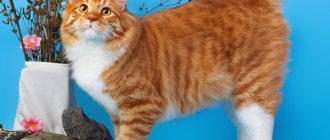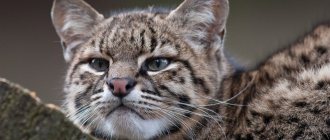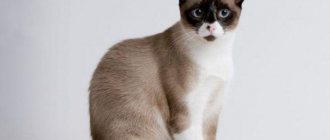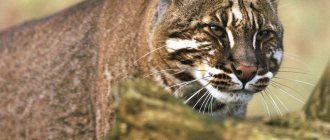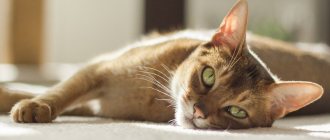There are a huge number of cat breeds. Owners of such animals treat their pets with special care. They take them to various exhibitions, trying to emphasize the exclusivity of their pet and its compliance with all breed standards. But there are also owners who are crazy about the simplest, yard cats. It is this type of animal that will be discussed in our article.
History of the barn cat
The hypothesis of universal kinship is not an allegory at all. Geneticists conducted a study of 797 animals and found that they descend from at least 5 common ancestors on the maternal line. Among the test subjects were both purebred and barn cats. So a homely mongrel and a tribal aristocrat Persian are not so far from each other.
It has been scientifically proven that the founder of the genus was a wild steppe cat. It still lives in the space from the Far East to North Africa, confirming the powerful natural immunity and ability of the genus to survive. After this, is it any wonder why a yard cat adapts to any living conditions?
Archaeologists claim that next to humans, these animals appeared somewhere in the Fertile Crescent region (on the modern map, an arc from Turkey to Libya). At this time, people began to master agriculture, food supplies attracted rodents, and cats followed them. This is how the first wave of migration of these animals occurred and no one needs to be convinced that they were all outbreds.
After 2.5-3 thousand years, cats spread to North Africa and Europe. The active stage of domestication of these useful animals has begun. But until now, people have not completely tamed their wayward cats.
Are they mongrel?
In recent years, many animal lovers have preferred to have mongrel pets in their homes. There are reasons for this: yard cats are not picky about food, they have strong immunity and care for them is very unpretentious. And yet it would be wrong to call these animals outbred. Both street and purebred cats have common ancestors who lived in the wild. Their modification occurred due to domestication, when the usual habitat and way of life became completely different.
Is there a street breed?
The division based on appearance happened much later:
- The history of breeds begins in 1000. Around this time, the first mentions of the Norwegian forest cat date back to this time. She is also considered the ancestor of the Siberian longhaired population.
- Later, Siamese, Abyssinians, Egyptian Mau, Persians and Turkish Angora were identified. Even the names clearly show the region from which they all migrated to Europe.
- 1758 Swedish naturalist Carl Linnaeus introduced the concept of Felis catus, a binomial name for the species.
- 17 years later (1775), his colleague from Germany von Schreber supplemented this section with the name Felis silvestris, identifying wild cats as a separate group.
- 1871 The first official cat show took place in London - 170 animals were shown in 25 categories.
From that moment on, the cat world was divided into purebred purebreds and simple street cats.
No one would dare to claim that outbred cats have any characteristic features. The point is not only in their diversity, but also in their amazing adaptability. Even formerly pampered pets quickly adapt to the street.
They have offspring with any homeless partner and thereby replenish the population of outbred animals.
There is a street breed of cats: they are counted not on the basis of size, build and color, but on the basis of the “cat’s soul.” Some of them value freedom much more than close communication with people.
Native cat breeds
Native cat breeds are those that were created by nature without human intervention. They appeared in the wild and in certain areas through natural selection, adapted to living in a specific climate. People were only required to notice and consolidate the breed characteristics.
Different countries around the world have their own native cat breeds. In Russia it is:
- Don Sphynx;
- Russian blue, Siberian and Altai blue-eyed cats;
- Ural rex;
- Kurilian bobtail.
Kurilian Bobtail
Names of foreign native cat breeds:
- Burmese;
- British;
- European Shorthair;
- Egyptian Mau;
- korat;
- Maine Coon;
- Norwegian forest;
- oriental;
- Persian;
- Singaporean;
- Thai;
- Turkish Angora and Van;
- Chartreuse.
Is there a yard breed?
The very concept of “breed” is very young – it is no more than 200 years old. Felinological organizations identify special traits and properties in individual cats, then prescribe and approve a standard with these unique characteristics, thereby giving the world a new purebred beauty.
Felinologists call yard cats outbred, although this statement can be considered erroneous, because the ancestors of all purrs were wild cats, which have different external characteristics and character, which is explained by different climates and ability to adapt.
Thus, native breeds with characteristic external data and character traits can be called yard breeds, because the distinctive characteristics of these purrs were formed thanks to nature, without the “selective” hand of man.
These native barn cats include:
- Turkish Angora.
- Celtic cat.
- Persian cat.
- Siberian cat.
- Siamese cat.
Types of outbred cats
The non-standard genotype and different living conditions explain the wide variety of outbred cats. An outdoor cat can give birth to offspring with very different appearances; it is almost impossible to predict the appearance of kittens in advance. As a result of the mixing of many native and purebred cats, and, consequently, the hereditary characteristics they carry, the individuals that are born have a very diverse color and body structure. Yard cats can be classified by the length of their coat.
Outbred cats can be very different
Short-haired mongrel cats
Simple mongrel cats most often have short hair, the colors of which can be very different. The striped color, the so-called tabby, clearly prevails; it can be found in combination with white, red and black. Uniformly colored individuals are also common; they can be pure black, red, all shades of gray, and sometimes white.
Short-haired cats are considered the southern type because they prefer to live in regions with mild, warm climatic conditions . Their coat is quite sparse, thin and often completely devoid of undercoat. The overall tonality is often light. Such animals rarely reach a weight of more than 5 kg; they have a slender, lean and graceful body with rather long and thin legs. The head is slightly elongated, straight ears are set high and slightly rounded. The tail is usually long and mobile, but can also be short. Eye color is often yellow or green. Although there are also cats with a different iris color.
Southern cats most often have short hair and almost no undercoat.
Long-haired mongrel cats
The northern type of yard cats acquired longer hair with a good dense undercoat, as the climate obliges this. In harsh and cold climates, animals grow larger, their weight often reaching 6 kg. The physique is massive, stocky, the bones are strong and solid. The limbs are thick, slightly short, the paws are wide. The head is round with large eyes of greenish-yellowish tones. The ears are erect and medium in size. The tail is thickened, long or short. The color of long-haired northerners is predominantly darker.
We recommend reading: Undocked Alabai (13 photos): pros and cons of Alabai with ears
In cold climates, cats are more likely to have long, thick fur.
A purebred cat can look very different, it all depends on what blood is mixed in it and the genes of which ancestors (distant and not so distant) predominate in it.
Under our own fence, we picked up a dirty outbred kitten that had obviously been planted on us. After the hygienic measures were taken, it turned out to be completely white, without a single dark spot. After several days it turned out that he was deaf. The baby turned out to be a blue-eyed albino.
Photo gallery: mongrel cats
Mongrel cats can have very original colors. Mongrel cats can have both short and long hair. Often, mongrel cats are very cute and attractive. Outdoor mongrel cats are unpretentious; they do not need to sleep on soft bedding. Sometimes mongrel cats look like ancient Egyptians. When a cat gets scared, it arches arched backs Outbred cats are excellent rat catchers On the street, outbred cats have to drink water from puddles Outbred cats are excellent mothers Street cats also sometimes get sick and look bad Outbred cats are also couch potatoes and sleep a lot On the street, cats often fight At first, cats try to intimidate each other
How much money does a kitten cost, should I pay or not?
When the issue with the appearance and desired character of the pet has been resolved, all that remains is to determine how much money you are willing to spend on purchasing the animal. Of course, if you plan to purchase a “status” kitten, or a show kitten with a good pedigree, you will have to pay an nth amount and, often, this amount is quite a “tidy” amount. Pedigree or non-pedigreed cats are better for home - it depends on your wallet.
If you do not expect to make a large financial investment for a small animal, then you should turn to numerous message boards about placing animals in responsible hands. In the Internet era, searches are simplified by the fact that advertisements are posted on the Internet with already attached photographs of “applicants for good hands.”
You can also ask your friends - perhaps one of them has a domestic cat that recently gave birth. And another option is to pick up a homeless person on the street. But it is more likely for brave altruists who are ready to take a risk and take into their home an animal without a clan or tribe. And this risk will be that there is a possibility of picking up a kitten with a whole bunch of infections. And the treatment in this case will fall entirely on the shoulders of the new owner.
In addition, it is almost impossible to find out what the parents of such a child were like if they did not all live on the street together. If you take a kitten through an advertisement or from friends, then you can find out a lot of useful information from the owners of the cat’s mother about her character, valuable qualities and any diseases, if any.
If you do not want to buy a “pig in a poke,” then the mixed-breed option is not for you. Choose a breed. It is best to buy purebred animals not at a bird farm or even at a pet store, but from trusted breeders or, again, from friends whom you personally know well.
The standard characteristics of a purebred cat (character, size, color, etc.) can be found out in advance from relevant sources, or from the breeder himself. After all, most breeds were bred through artificial selection, therefore each breed differs from any other precisely by those qualities that have been maintained in it from generation to generation by breed specialists.
When choosing a purebred animal, you can know in advance how it will grow with a high percentage of accuracy.
If we take a closer look at the difference between purebred and outbred cats, we can highlight some of their main advantages and disadvantages.
Features of street cats
Yard cats have certain characteristics in appearance and character. Most of them are similar in length and thickness of fur, body size and proportions, disposition and temperament. In addition, living in harsh conditions left its mark on their health and life expectancy. As for color, in street cats it can be either the most common or rare.
Common and rare colors
The shades of fur of yard cats are so diverse that their purebred brothers may envy them. Four-legged vagabonds can be found in a variety of colors, but most of them have a spotted or striped coat (see photo). This is how nature intended it, because such protective colors allow its owners to disguise themselves in case of danger or waiting for a victim. The rarest coat color for outdoor cats is white. Meeting a snow-white beauty on the street is real luck.
Length and thickness of coat
Among yard four-legged inhabitants, owners of long hair are rarely found. Usually such animals are short-haired. Tailed mongrels, depending on the characteristics of the climate in which they were formed, are conventionally divided into 2 types: northern and southern. The mustachioed “northerners” have long, thick hair, while the “southerners” have short hair without a pronounced undercoat layer. It is impossible to meet a hairless barn cat. Even if a street kitten is born completely hairless, it is unlikely to live long in harsh conditions.
Body type and dimensions
Representatives of the northern type have a dense, massive body. Four-legged “southerners” have a more graceful, less heavy build. Most tailed mongrels are medium in size. As for their weight, it usually ranges from 3 to 6 kg. These are average parameters. On the street you can meet both larger and very small animals.
Character and temperament
Outdoor kittens and adult cats have an energetic temperament. This is not surprising, because they literally have to fight for a place in the sun, so they simply have no time to yawn. Characteristics of tailed street dwellers:
- Lack of aggression and resentment. Such animals are extremely careful in showing their emotions, so it is difficult to understand what they really feel.
- Wary attitude towards people, especially strangers. If you bring a kitten or an adult animal home from the street, at first the new four-legged family member will shy away from everyone. He will trust the inhabitants of the home only after he is convinced of their good feelings towards him and the absence of a desire to offend him.
- Independence and self-sufficiency. These qualities are dictated by the harsh conditions of existence.
- A reverent attitude towards any manifestation of affection. Four-legged mongrels are so unaccustomed to affection that once they enter the house, they accept it with great gratitude.
Types of appearance: a combination of simplicity and grace
A cat without a pedigree can have any coat color. Gray, red, tabby, blue, and tricolor cats are often found. A black cat with a white collar and socks is considered popular. But pure white outbred animals are rare, so if a kitten with white fur is born in the litter, then most likely his dad has genes of a certain breed in his blood.
The animal has an average body length, weight ranges from 3.5-5 kg. Conventionally, outbred mongrels are divided into 2 types:
- Northern. This species is distinguished by its harsh appearance, massive build, and long thick fur, as these cats live in difficult climatic conditions.
- Southern. This variety has an appropriate description: an elegant, graceful body, a thin skeleton, short hair with no pronounced undercoat.
Return to contents
Making a new friend
The undoubted advantage of outbred cats is that no costs are required to purchase them. Usually such pets are acquired through friends or through an advertisement. Often, stray kittens are picked up on the street. If an animal is taken from home and there is a choice, in order not to make a mistake with the character and health of the kitten, you need to take a closer look at the following signs:
- the kitten readily approaches you, tries to flirt and does not try to show aggressiveness;
- the kitten is distinguished by its external attractiveness, meekness, agility, playfulness, playfulness and does not look sad, dejected or apathetic;
- holds his head up normally and walks or runs with absolutely no limp;
- does not twitch his head, does not have a runny nose, cough, or other external painful signs;
- the kitten's skin looks clean and healthy, without irritation, dirt, scabs or flea excrement;
- the animal's coat is shiny and clean, without bald spots or tangles (matted);
- no liquid or other discharge from the eyes, nose and ears;
- the third eyelid (the so-called nictitating membrane) does not cover part of the eye;
- teeth look clean and free of tartar, there is no unpleasant odor from the mouth;
- The gums of a healthy kitten are pink and there are no signs of bleeding;
- the stomach feels quite strong and at the same time not bloated;
- the anus is clean, without remains of feces, there are no visible signs of diarrhea or worm segments (they, if present, come out of the anus and look like grains of rice).
We recommend reading: Beauceron: everything about the dog, photo, description of the breed, character, price
It is recommended to wean a kitten from its mother no earlier than 2.5–3 months. At this age, the baby will tolerate separation without consequences for the psyche. He is already accustomed to the tray and “adult” food.
Cats are considered social animals. Therefore, experienced felinologists recommend, if possible, purchasing two kittens at once. For the company. Especially if the owners have to be away from home for a long time.
The offspring of outbred cats can be of a wide variety of colors
Cleanliness is the key to cat health
Caring for the appearance of a mongrel pet will not cause much trouble. The coat should be combed 1-2 times a week with a stiff brush to remove dead hair. During molting - 2-3 times. To avoid ear mites, wipe your ears with a cloth moistened with hydrogen peroxide. Use special ear drops. Remove discharge from the eyes with a soft cloth. Train your kitten to use a scratching post. This will save you and your cat from the unpleasant procedure of trimming its claws. You need to bathe your pet as soon as it gets dirty. But not often. Cats take care of their fur coats themselves. Almost everyone, with rare exceptions, does not like water procedures.
A good toilet for your beloved cat
When choosing a toilet for a kitten, focus on an adult cat, so as not to buy a new one when it grows up. The pet must enter it entirely. The height of the sides is not lower than 6 cm. It is better to use clumping filler for the tray. It absorbs odor well and simplifies the cleaning process. If finances allow, then the best option would be a box (dry toilet) with replaceable cassettes.
Light and air
Outdoor cats need fresh air and sunlight. Ultraviolet light promotes the production of vitamin B. If your pet constantly lives in an apartment, surprise him - in good weather, take him for a walk in the nearest park or forest. Use a harness with a leash for this. Avoid asphalt. For delicate cat paws, soft soil or grass is better. Try to avoid crowded areas of cars, people and dog walking so as not to scare your pet.
Barn cat Gray
A couple of times he quickly ran from one yard to another along the work area adjacent to the warehouses, where I sometimes went out to get some fresh air. One day I called out to him and he stopped. He let me come to him. He was thin, with matted and unkempt fur, covered in some burrs. His tail, apparently, was once broken in two places, and subsequently fused incorrectly, now resembling the shape of a fairly bent corkscrew.
At first, this street cat came for food once a day, at the same time. It was possible to set the clock by it, so accurately did he know when a bowl of milk would appear on the roof of the garage, adjacent to the back wall of our yard.
After a few days, the cat realized that now there was no need to scavenge for discarded bread, and began to spend more and more time on the roof. And spend more time on your hygiene. He cleaned his skin until it shined and straightened up slightly.
It often happened that there were busy days in terms of work, and I forgot not only about feeding the cat daily, but also about my own lunch. Then someone would come from the warehouse to say: “There’s a cat demanding you!”
Within a couple of weeks, Gray turned into a fluffy handsome man. He became completely tame, affectionate and completely relaxed, graciously allowing himself to be photographed at any time.
A week later, he began to bring his green-eyed friend, the same yard cat, to dinner. When treating her, he always made sure that she knew when to stop, at a certain moment tactfully moving her muzzle away from the bowl.
Then other cats began to appear periodically on the roof. I had to bring more milk and sausage to work than usual. And one bowl was not enough for everyone.
A couple of times I happened to see an unusual street cat on the same roof, which never approached the bowl, but only sat at a distance, like a sphinx with an unblinking gaze, watching what was happening. There was something frightening about her.
Not without its drawbacks
If you pick up a mongrel kitten on the street, you risk bringing a sick animal into your home. Be sure to take him to the vet right away. A little street child may have lichen or fleas. It may be infected with an infection or worms. If a purebred parent took part in the birth of a kitten, then, in addition to distinctive features, the baby can inherit genetic diseases inherent in the breed.
Well-groomed fur is the key to success at the exhibition
Scars decorate a wild cat
Outbred cats can take part in exhibitions. Felinologists have identified them in a special class - “domestic cat”. There are special beauty contests for them. Any outbred pet can take part in them. An exhibition of outbred cats is an event no less serious than competitions of elite breeds. At outbred exhibitions, an animal with any external signs of “eliteness” or showing signs of aggression cannot win. The presence of such defects as a broken tail and extra toes is allowed. What is unacceptable for purebred cats. Even injuries and scars can decorate the appearance of a domestic cat.
Character and habits
What character traits will prevail in a mongrel primarily determines the owner’s attitude towards the animal. If a simple cat lives in good conditions, is loved, cherished and treated like a purebred, then the animal will behave accordingly. Otherwise, the pet's survival instincts will be more developed. If the owner offends a cat, he will grow up wild, unsociable, and aggressive. However, sometimes the mongrel shows anger and aggression for no reason. In this case, only patience and love will help.
How to accustom a cat to an apartment?
If outbred kittens come into the house from the street, the first step is to quarantine them - isolate them from family members and other animals for 10-14 days. During this time, the babies receive vaccinations and treatments.
Tray training for outbred cats follows the standard scheme:
- selection of container and filler;
- installation in a place convenient for the animal;
- monitoring the kitten and directing it to the litter box at the right time;
- consolidation of the skill.
It has been noted that outbred cats have a developed sense of self-esteem and demonstrate it from a young age. Force and coercion can lead to the desire to do the opposite, contrary to the will of people. But this is still considered an exception - clean cats themselves do not want to live among sewage.
Should stray cats be taken home?
The world is not without kind people, and the ever-decreasing population of stray animals always needs human help. The number of outbred cats in homes is several times higher than the number of their well-bred counterparts.
Veterinary experts consider three motives for which people take outdoor cats into their homes:
- compassion and desire to reduce the number of suffering animals;
- You don’t have to pay for a street kitten;
- a variety of types of feline “mongrels”, among which there is always a type suitable for “adoption”.
It has been noted that representatives of the yard cat breed almost never end up on the street again. People take full responsibility for the life of a stray animal and treat it with the same care as they treat expensive elite breeds.
Most often we are talking about yard kittens - in adulthood, animals are much less likely to find a new home.
Choosing a purebred cat
The decision is best made after the consent of all family members. Attention is drawn to the following circumstances:
- Age. A young cat will more easily enter a new environment and adapt to it. She had not yet developed the habits of a wandering life, and her character had not hardened in the struggle for survival.
- Health. Ordinary street kittens traditionally have strong immunity and natural endurance. Unlike purebred cats that undergo inbreeding, they rarely have genetic mutations. A healthy kitten should be playful, easy to run and jump, with shiny, even fur, pink gums and clean mucous membranes.
Appearance also plays a role in the selection process. They look at her first of all - after all, the aesthetic desire to own a beautiful animal overshadows everything.
The task is greatly simplified when it comes to the children of a domestic mongrel cat. Here the parents are already known (at least one of them), the kitten is under supervision and warm, and the mother cat has adequate feeding and the opportunity to raise her offspring.
No matter how healthy and active a mongrel kitten may seem, it must be shown to a veterinarian. Neglected childhood illnesses can turn into big problems.
Video: choosing a kitten
Features of caring for outbred cats
There are no differences in the responsibilities for keeping outbred and purebred cats. Both the first and second require equal attention:
- The fur is combed out, especially in long-haired animals. A beautiful fur coat is considered a universal indicator of health and psychological state. If it loses its shine and the hairs do not lie flat, then the animal has problems.
- The mucous membranes of the eyes and nose must be kept clean. To do this, they are periodically processed and unsightly crusts are removed.
- The ears are carefully cleaned with a cotton swab or swab.
- If necessary, trim the claws.
- The teeth of the descendants of feline mongrels usually remain healthy for a long time, but from time to time they also need to look into their mouths.
We recommend reading: Asian tabby: description, character, maintenance, care, photos
The only relaxation in maintenance and care is the absence of the need to select an appropriate gentleman for a mongrel cat. Here the choice is so great that no one has any difficulties.
Health and life expectancy
Most four-legged street dwellers are in good health and free of any genetic diseases. This feature was formed over centuries in wild conditions and was passed on to modern domesticated outbred cats.
Strong immunity is the basis for the long life of tailed mongrels (which does not negate the need for their vaccination and treatment for parasites). On average they live about 10–12 years. Among them there are often true centenarians, living up to 16–17 years.
Domestic mongrel pets usually live much longer than their counterparts who were not lucky enough to find loving owners. This is influenced by a well-fed life, regular care and the opportunity to use veterinary help in case of illness. Street animals must search for food on their own and often die, unable to cope with disease and hunger, becoming a victim of a dog attack or freezing to death.
Castration and sterilization
Spaying and neutering operations are carried out in cats to stop reproductive function. Castration, despite its “bloodiness,” is still preferable. It relieves the animal from the sexual instinct, and the owners from the troubles that accompany “hormonal explosions” during cat desire.
Neutered pets are healthier. The risk of cancer is reduced. The likelihood of urolithiasis is reduced. In the absence of sexual desire, cats are more oriented toward their owners. They pay more attention to them, become affectionate, obedient and friendly.
In cats, castration should be carried out at the age of 7-8 months, before the first heat and before final puberty.
It is better to castrate and sterilize cats in specialized clinics. Although recently, home surgeries have become increasingly popular.
After castration, the cat requires special care and attention.
Castration and sterilization are performed under general anesthesia. Cats are very sensitive to the effects of drugs and require special care after surgery. After the procedure, it is better to leave your pet for several hours in the hospital under the supervision of doctors. When you bring the cat home, place it on its side in a warm place and cover it with a blanket. Avoid hypothermia, avoid drafts. Especially if your pet is short-haired. He will sleep for the first 24 hours. Under anesthesia, cats sleep with their eyes open. Close his eyelids from time to time to avoid drying out the cornea.
Cats recover completely from anesthesia within a few days. At this time, their coordination is impaired and orientation in space is lost. Do not allow your pet to climb into high places to avoid falls and injury.
Feeding mongrel cats
Feeding a mongrel street dweller can be a bit of a hassle. There are fewer problems with babies, but if a cat has managed to live in freedom and is accustomed to picking up food from the ground, it is almost impossible to re-educate it.
- At an early age, babies are given diluted goat's milk or special infant formula. Outbred kittens separated from their mother prematurely have not yet learned to eat and will require additional attention.
- For adolescents, the diet is increased by boiled minced meat in a liquid consistency or age-appropriate industrial food.
- Closer to six months, meat, fish, dairy products, vegetables and fruits are introduced into the cat’s menu.
- It is necessary to provide feed yeast and vitamin and mineral supplements. No matter how strong the natural immunity of a purebred cat may be, its support is mandatory.
- There must be water next to the food. The animal's access to it is left free around the clock.
Choosing cookware is not a difficult task. Plastic bowls are convenient and inexpensive, but their porous structure traps microscopic food debris. Therefore, it is necessary to thoroughly wash surfaces to prevent the growth of bacteria.
Those with large mustaches are the most picky about dishes. If they cling to the sides of the bowl, the cat begins to experience discomfort.
Maintenance, feeding and care at home
Outdoor cats are easy to care for. They need to be cared for in the same way as purebred pets:
| Hygiene procedure | Frequency of execution | Recommendations |
| Combing | 1–2 times a week | You need to comb your tailed friend with a special rubber brush-mitten. |
| the washing up | As the wool gets dirty | Bath cats with pet shampoo. |
| Cleaning the ears | 1–2 times a week | Natural secretions and dust are removed with a cotton pad moistened with warm boiled water or a special solution. |
| Eye cleaning | ||
| Teeth cleaning | As plaque forms | A special toothbrush and toothpaste are used. |
| Nail trimming | As it grows | The claws are shortened with a special claw cutter. |
To comfortably accommodate a mongrel animal, you need:
- arrange a sleeping place for him in a warm, quiet room, where there are no drafts;
- tray with or without filler;
- scratching post;
- bowls for food and water;
- walking harness;
- play complex and (or) toys.
If a pet is not purebred, this does not mean that it can be fed with cheap ready-made food or food prepared independently from low-quality products. Information about feeding your cat:
| Types of cat food | Allowed food | Forbidden food |
| Ready | Premium food (Brit Premium, Organix, Probalance, Hill's, Eukanuba) and super premium food (Fitmin For Life, Brit Care, Summit, Blitz "). | Cheap products (“Friskies”, “Whiskas”, “Kitekat”, “Gourmet”, “Felix”, “Cat Chow”, “Gemon”, “Purina One”, “Stout”). |
| Self-cooked |
|
|
Advantages and disadvantages
Despite the fact that yard cats do not have such exclusive characteristics as their purebred counterparts, they are nevertheless not without merit.
- Lasting immunity. Breeding breeds using selective breeding methods has greatly weakened the immune system of animals. This is why the life expectancy of street cats is many times higher than that of purebred pets. Yard cats have strong protective functions of the body and are able to resist many infections.
- Personality Such animals tend to be docile in nature. They become very attached to the owner who picked them up on the street.
- Reproduction. Since yard cats do not need a purebred partner, finding a mate for them to reproduce will not be difficult.
- Indispensable in the household. Outdoor cats are excellent mouse hunters. Nature endowed the animal with these qualities, and it is among the domestic representatives of the family that this instinct is much more developed.
- Price. You don't need a big investment to get a pet. You can pick up a cute, albeit not purebred, kitten on the street. Some cats even choose their own owner, coming to visit and “imposing” themselves.
- Exhibitions for yard cats. You heard right. Indeed, there are special exhibitions designed for outbred cats. On them, judges evaluate the external characteristics of the animal and its grooming.
The main and, perhaps, the only drawback of street cats is their unpredictability of character. Stray cats are careful in expressing their emotions, therefore, when taking such an animal from the street, you cannot be sure that it has a calm, easy-going disposition. Otherwise, mustachioed-striped tramps successfully compete with their purebred brothers.
It is not at all difficult to acquire a reliable friend and an excellent companion in the person of a simple mongrel domestic cat. The lack of pedigree does not make such pets worse than purebred animals; in many respects they are even superior to their titled brothers.
Sources
- https://MurKoshka.ru/porody/dvorovaya-koshka.html
- https://litbro.ru/interesnoe/besporodnaya-poroda-koshek
- https://kot-pes.com/besporodnaya-koshka/
- https://prohvost.club/koshki/porody-koshek/besporodnaya-koshka.html
- https://kotologia.com/porodyi/dvorovaya.html
[collapse]
Vasily, Timofeich and Villain
Timofeich was brought and launched into the premises rented for the store by one of the neighbors, who also rented space next door. The cat slowly walked around the perimeter, rustled for a few minutes in one of the corners and returned with a strangled mouse, carefully placing it next to him. This moment was captured in the photo; I do not illustrate it here for moral and ethical reasons.
So Timofeich began to rely on allowance at a newly opened retail (not grocery) outlet. He regularly came to work at 9:00 every day. In a few days he caught all the mice, each time showing me his catch, as if hinting that he fully deserved his modest ration. He spent most of his time indoors, only occasionally going away somewhere on his own business.
One day this cat really surprised me. One evening I stayed late at work, dealing with 1C:, forgetting about time. Suddenly Timofeich, who was sitting at my feet, softly jumps onto my lap, takes my hand from the table with his front paws (it sounds wild, I understand) and puts it on his furry head!
The cat Vasily came to us a couple of times a week, always appearing unpredictably and disappearing just as mysteriously. He was the kindest, laziest, heaviest and softest cat of all) You can’t say that about him from the photo.
Holding this short-haired white and gray cat in my arms was an incomparable pleasure. I am sure that if he suddenly fell into the hands of a person completely indifferent to cats, or even a cat hater, these representatives of the human race would once and for all change their attitude towards cats - for the better. But such cats are rare, I only met one like this once)
A shabby, gangster-looking street cat, to whom the nickname Villain immediately stuck, appeared in the yard a few weeks later. The next day he disappeared, a couple of weeks later he “looked for a light” again. So he appeared in raids throughout the year that I worked outside of Voronezh.
What’s interesting is that these cats did not engage in showdowns and clarification of territorial relations, as sometimes happens, among themselves. coexisting quite peacefully in a relatively small area. Perhaps because there was enough food for everyone. There were also shops nearby, including grocery stores. And there were enough people who were not indifferent to cats.
